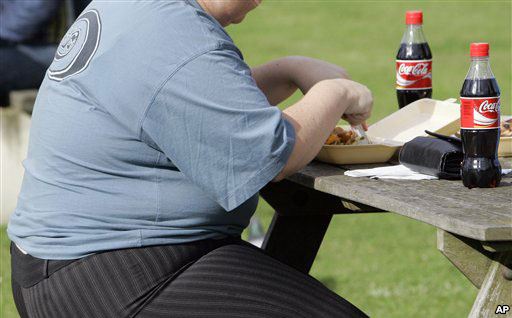
The appalling diets of the nation’s teenagers have been exposed by a report which shows that many are already putting themselves at risk of diabetes, obesity and heart disease. And last night health experts warned that fruit juice – seen by many as a healthy option – should be drunk no more than once a day because of its high sugar content.
Girls and boys aged 11 to 19 typically eat 42 per cent too much sugar and 14 per cent too much saturated fat.
Only 10 per cent of teenage boys and 7 per cent of teenage girls manage to get their five portions of fruit and veg a day.
Adults do not fare a great deal better. Only a third get their five-a-day and the diet of the average adult exceeds recommended sugar limits by 10 per cent.
The report, the Government’s National Diet and Nutrition Survey, also shows that children aged ten and under typically exceed the recommended daily limit of sugar by 34 per cent.
Their main sources of sugar are fruit juice, soft drinks, cereal bars, biscuits and cakes.
It reveals that adults are eating half the recommended weekly amount of oily fish – which protects against heart disease, cancer and dementia – while teenagers and children only manage a fifth of this amount.
The survey, which involved 4,000 adults and children between 2008 and 2012, says 48 per cent of men and women have above-normal levels of cholesterol, putting them at higher risk of heart disease and strokes.
Simon Gillespie, chief executive of the British Heart Foundation, said: ‘This study paints a clear picture that too many people, especially children, are not eating healthily enough.
‘This puts them at greater risk of coronary heart disease, type 2 diabetes and obesity now or in the future. There is no magic bullet to solve this problem. Parents, schools, restaurants, retailers and the food industry all have a role to play.
‘But the Government can fire the first shot by implementing a 9pm watershed ban on junk food marketing to stop children being bombarded with advertising about products high in fats, salts and sugars. We also need stringent regulation to protect children from online marketing tactics.’
There is also concern that policies such as the NHS’s Change4Life programme are having little effect because only healthy adults and children pay any attention.
The initiative, which has cost taxpayers £65million since its launch in January 2009, consists of television adverts, a website, a helpline and locally-run sports clubs all aimed at curbing the obesity epidemic.
The scheme also produces posters for schools, community clubs, GP surgeries and hospitals urging the public to eat their five- a-day, take regular exercise and cut portion sizes.
Dr Ian Campbell, of the National Obesity Forum, said: ‘In spite of a raft of measures designed to encourage us to eat a healthier diet we are, as a nation, failing miserably.
‘If we really care about the health of our children we need to take far more decisive action. ‘We need to regulate the food industry to make healthy choices easier, more attractive and cheaper.’
Dr Alison Tedstone, the chief nutritionist at Public Health England, the Government agency that released the report, said fruit juice was a good option as one of the recommended five fruit portions a day.
But she warned: ‘It should only be drunk once a day and with a meal because it can be high in sugar.’
In March, Dame Sally Davies, the Chief Medical Officer, said the Government may have to introduce a sugar tax to help make the nation’s diet more healthy.
Later that month the World Health Organisation urged the public to cut their sugar intake by half to six teaspoons a day.
Yesterday Labour MP Keith Vaz called for food labels to include the numbers of teaspoons of sugar in all products.
Source: daily mail











